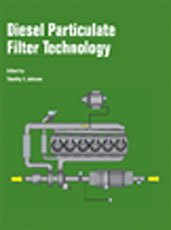Technical Paper
A Computational Model Describing the Performance of a Ceramic Diesel Particulate Trap in Steady-State Operation and Over a Transient Cycle
1999-03-01
1999-01-0465
A model for calculating the trap pressure drop, various particulate properties, filtration characteristics and trap temperatures was developed during the steady-state and transient cycles using the theory originated by Opris and Johnson, 1998. This model was validated with the data obtained from the steady-state cycles run with an IBIDEN SiC diesel particulate filter. To evaluate the trap experimental filtration efficiency, raw exhaust samples were taken upstream and downstream of the trap. A trap scaling and equivalent comparison model was developed for comparing different traps at the same volume and same filtration area. Using the model, the trap pressure drop data obtained from different traps were compared equivalently at the same trap volume and same filtration area. The pressure drop performance of the IBIDEN SiC trap compared favorably to the previously tested NoTox SiC and the Cordierite traps.


